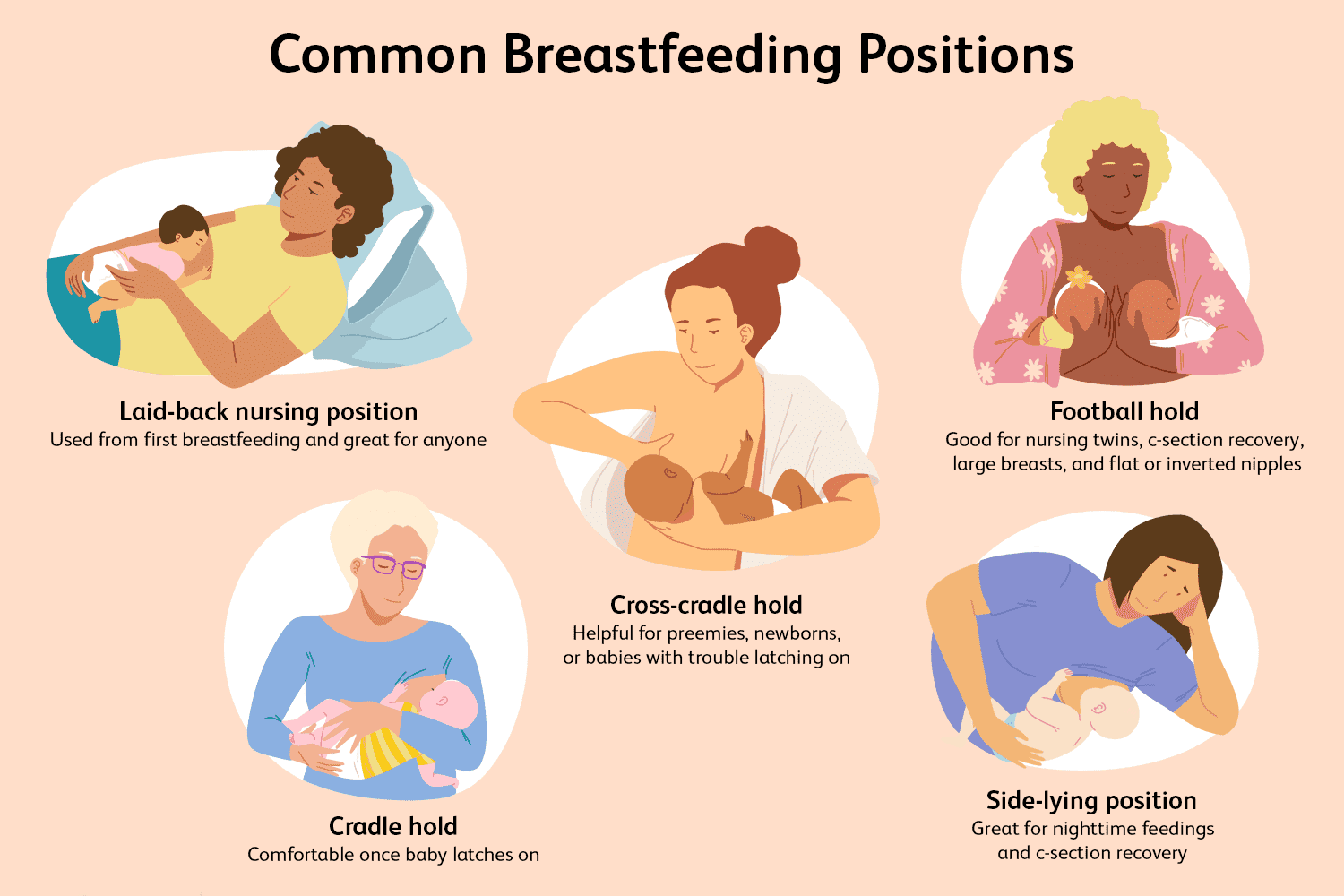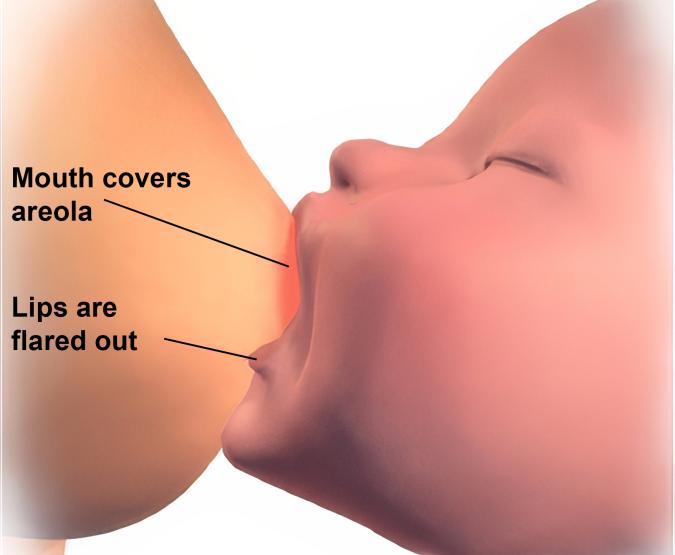Breastfeeding
Breastmilk is the only food and drink your baby needs for the first six months for healthy growth. At six months, start giving the baby solid foods. We suggest you keep breastfeeding your baby for two years or more.
Every baby is unique. It will take time and practice for you and your baby to learn to breastfeed. For most moms, it takes 4 to 6 weeks to feel confident breastfeeding.
What to expect after delivery
After your baby is born, we will help you place your baby against your skin for at least the first hour. Skin-to-skin care helps:
- you and your baby bond
- calm your baby
- stimulate your milk production
- regulate your baby's temperature, heart rate and blood sugars
If you are unable to practice skin-to-skin care after the birth, your partner can also practice skin-to-skin with the baby.
Benefits of breastfeeding
- fewer or less severe ear infections and allergies
- decreased risk of sudden infant death syndrome, respiratory and gastrointestinal illnesses
- babies are less likely to have diabetes, certain childhood cancers and obesity
- breastfeeding is a natural form of child spacing through lactation amenorrhea method (LAM)
- lower risk of excessive bleeding after birth and decreased risk of breast and ovarian cancer for the birthing parent
Breastfeeding basics
- It is your right to breastfeed anywhere, anytime.
- Feeding often and for as long as your baby wants will help you make breastmilk. The more breastmilk your baby drinks, the more milk you will make.
- Let your baby guide the number and length of feedings. Breastfeed whenever your baby shows signs of hunger. They will stop feeding when full.
- Offer the breast before your baby cries by watching for early signs of hunger (sucking motions, smacking lips, putting fist or fingers into mouth, searching with an open mouth).
- It is normal for breastfed babies to feed at least eight times in 24 hours.
- All babies grow differently. Growth spurts often occur at three weeks, six weeks, three months and six months.
- Find a breastfeeding buddy. This is someone who has had a positive breastfeeding experience and can help you. They can share breastfeeding knowledge to help you on your breastfeeding journey.
Breastfeeding in the first 24 - 48 hours
Colostrum
Colostrum, sometime known as liquid gold, is a thick sticky yellow milk that you produce during pregnancy and during the first few days after birth.
Colostrum contains large amounts of living cells that protect against bacteria and viruses. It acts as a baby's first vaccine.
Even though your body makes a small amount, colostrum is high in nutrition and is all your baby needs in the first few days.
Normal feeding
At first your baby may be sleepy. You may need to try changing your baby's diaper or placing the baby skin-to-skin to help them wake up and feed.
It is normal on the second night for your baby to feed often and cry if taken off the breast. This can be stressful for new parents but is normal for newborns.
How often to breastfeed
Breastfeeding early and often will help you make enough milk for your growing baby. The more often you feed, the more milk your body will produce.
Babies feed frequently during the evening and sometimes through the night. This also helps to increase your milk supply.
Try to breastfeed at least eight times in 24 hours. You may can feed more if your baby shows signs of hunger.
Holding your baby
Here are a few ways you may choose to hold your baby while breastfeeding.

Helping your baby latch
Breastfeeding is more comfortable when your baby has a good latch. You can try these tips to help your baby latch well to the breast.
- Make sure your baby is facing you, tummy-to-tummy and face-to-breast.
- Support your baby behind the neck and shoulders. Do not push on the baby’s head.
- Wait for the baby to open their mouth wide like a yawn with tongue down.
- Bring the baby to the breast chin first, with their head slightly tipped back. The baby’s nose will be close to the breast but will still have room to breathe.
- Your baby will have a large portion of areola (area around the nipple) in their mouth when they have a good latch. The baby’s cheeks will look full and rounded.

Signs that your baby drinks enough
- You can hear or see your baby swallowing and can see jaw movements.
- You may hear your baby make a “ca” sound.
- Your baby seems content and satisfied after feeding.
- Your baby pees and poops the right amounts based on their age.
Expressing and storing breast milk
You can express breastmilk by hand or with a breast pump. Removing milk from your breasts will help your milk supply.
You may need to express your breastmilk to:
- give breastmilk your baby if they aren’t able to latch
- give breastmilk for your sick or preterm baby
- make sure your baby has breastmilk while you are away from your baby
- soften your breasts if your breasts are full or engorged
- keep your milk supply if you cannot breastfeed
How to express your breastmilk by hand
- Wash your hands well.
- Hold your baby skin-to-skin. You can gently stroke and massage your breasts to help the milk flow.
- Put your thumb and index finger 1 to 1.5 inches outside the areola. Press the thumb and index finger back towards your chest.
- Roll your thumb and index fingers toward the nipple. Avoid pulling on the nipple.
- Relax your fingers on the breast.
- Repeat these steps, moving your fingers around the entire breast. Keep doing this until the milk stops flowing. Switch hands if you need to and move from one breast to the other.

Storing breastmilk
It is important to know how to store your breastmilk safely.
| How milk is stored | How long it can be stored |
|---|---|
| Room temperature | 4 hours |
| Insulated bag with frozen gel pack | 24 hours |
| Fridge | 48 hours |
| Freeer compartment of a one-door fridge | 2 weeks |
| Separate freezer compartment in fridge | 3 - 4 months |
| Deep freezer (-18° C) | 12 months |
Thawing frozen breastmilk
Always use the breastmilk that has been frozen longest, first. To thaw breastmilk, put it under warm running water or in the refrigerator.
Thawed breastmilk must be used within 24 hours. After 24 hours, it is not safe for your baby and you must throw it out. Never refreeze breastmilk.
Do not thaw or warm breastmilk in a microwave. Microwaves heat unevenly, forming hot spots that can burn your baby. The microwave can also destroy parts of the breastmilk that your baby needs.
Cup feeding
You can use a cup to feed your baby when you are not able to breastfeed. You might choose to cup feed if:
- your baby needs extra supplements along with breastfeeding
- to avoid nipple confusion
You can always ask your nurse for help.
Equipment
- small clean cup
- clean cloth
How to cup feed
- Make sure the baby is calm and awake.
- Wrap the baby well so their hands do not bump the cup.
- Place the clean cloth under the baby’s chin.
- Pour suggested amount of expressed breastmilk or formula into the cup.
- Hold the baby in an upright sitting position on your lap. Make sure you are both comfortable.
- Let the edge of the cup touch the baby’s lower lip.
- Tip the cup until the milk reaches baby’s lips. Do not pour milk into the baby’s mouth.
- The baby will lick the milk with their tongue or may sip it.
- Keep the cup in the same position during the feed. The baby may pause during the feeding. Do not take the cup away when the baby stops sipping.
- Burp the baby after every 15mL (1/2 oz).
Adapted from ‘Breastfeeding Committee for Saskatchewan Cup Feeding Your Baby (2015).’
Breast engorgement
Breast engorgement means your breasts are too full. It happens when milk is not taken out of the breasts often enough or in large enough amounts. Engorgement usually happens between two to five days after birth.
Your breasts may be engorged if one or both breasts:
- are very full, heavy, hot, red, painful or tender
- feel lumpy, including the breast tissue under your arm
- have nipples that are flatter than usual
Protect your breasts
You can keep your breasts from becoming engorged by:
- latching your baby correctly to the breast
- feeding your baby at least eight times in 24 hours
- feeding your baby when they show early feeding cues
- not using soothers or bottles
- expressing milk from your breasts only if you miss a feeding
Caring for engorgement
Before feeding
If milk is dripping or you can express milk, apply warm, moist heat to your breasts for two to five minutes. Massage your breasts gently in a circular motion (start under your arm and move towards the nipple). Then try to hand express or pump milk from the breast.
Between feedings
- apply a cold compress to your breasts
- wear a supportive bra
- take pain medication about 20 minutes before feeding
When you need help
Call the Healthy Beginnings Hotline at 780.413.7990 or your lactation consultant if you need help with breastfeeding or breast engorgement.